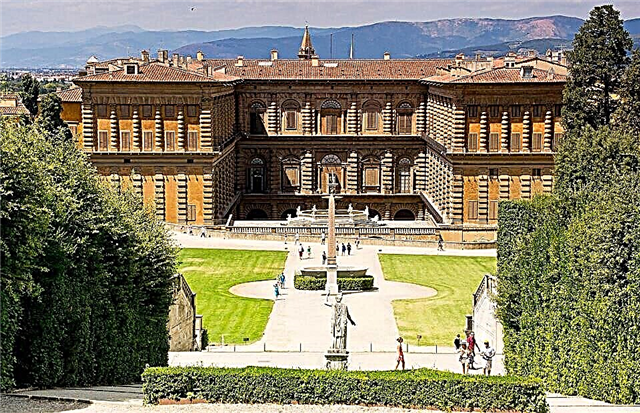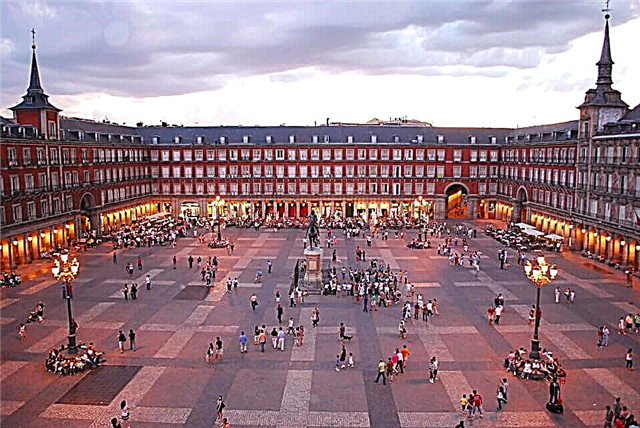The central square of the city is interesting in that it has preserved an integral architectural ensemble, consisting of buildings built at the beginning of the 19th century. Borshchev's house, fire tower, guardhouse and public places perfectly fit into the spatial perspective and perfectly harmonize with each other. In addition, the main square of Kostroma is a favorite place for walking city residents and tourists who come here.
How Susaninskaya Square was created
The history of the square, named after the Kostroma peasant, has more than 230 years. It began to be built after the adoption of the general urban planning plan in the city - in the 80s of the 18th century. It was during the reign of Empress Catherine II, and it is not surprising that the new Kostroma Square was immediately named Catherine Square.

View of Susaninskaya Square from Sverdlova Street
According to the original plan, the area was supposed to be made semicircular, but later it acquired the shape of a polyhedron. In 1823 the square was covered with cobblestones. And in 1835, by the decision of Emperor Nicholas I, it was renamed into Susaninskaya. Today this part of the city consists of a large public garden located in front of Gostiny Dvor, and the square itself, from which the streets radiate out like rays throughout the city.
Fire Tower
City architect Pyotr Ivanovich Fursov became the author of the tallest building in the central square of Kostroma - the fire tower. Today it is rightfully considered one of the city's visiting cards.

Fire tower on Susaninskaya square
The tower was built in the style of mature classicism in the late 1820s. According to the plan of the then governor K.I. Baumgarten needed a tall building both to decorate the main square and to alert residents in the event of a fire. The two-story base of the watchtower turned out to be so spacious that all the necessary units of the city fire service were freely located in it.
Above the tower, as if "growing" from the main building, a beautiful lantern with a balcony was erected. When, in the middle of 1830, Emperor Nicholas I, who was passing through Kostroma, publicly expressed his admiration for the tower, it was considered the best in the Russian province. Almost all the time the building of the fire tower was used for its intended purpose. And only recently it was handed over to the city museum, and there are expositions that tell about the history of firefighting in Russia.

Guardhouse on Susaninskaya Square
Guardhouse
On the right side of the watchtower there is an unusual building, which in previous years housed a guardhouse. It was erected in the mid-1820s to replace a dilapidated wooden structure. Kostroma Architect P.I. Fursov, a recognized master of the Empire style, created the building extremely magnificent for the places of detention of the guilty. True, it was not ordinary soldiers who served their sentences here, but only noble officers. Therefore, the deliberate solemnity of the facades of the "military prison" turned out to be quite appropriate.
Today, the guardhouse building is given to the city museum, and military-historical collections are exhibited in its halls. Here you can see rare exhibits from the 12th century to the present day: ancient weapons, ammunition, maps of military campaigns and personal belongings of soldiers.
Borshchov's mansion

Borshchov's mansion on Susaninskaya square
Perhaps the most representative building overlooking Susaninskaya Square is a large classical mansion, which is more like a palace in its dimensions. It is called Borshchev's house.
The exact date of the construction of the mansion has not been preserved. Some historians say that it was erected in 1824, others claim that it happened 6 years later. The architect who prepared the project of the building is also unknown. It could have been N.I. Metlin, and P.I. Fursov.

The owner of the mansion was the famous Kostroma, Senator and Lieutenant General Sergei Semenovich Borshchov. He came from a noble family of nobles who served at the royal court for several centuries. In 1817, Borshchov retired and decided to build a stone house for himself instead of the old mansion. Construction began in 1819 with the first wing. And then they built the whole large building as a whole.
The facade of the central part of the magnificent mansion is decorated with eight austere columns and a portico. And its side parts have two floors. Among the famous guests, Tsar Nicholas I and the future Emperor Alexander II visited the house. Poets also came here - Vasily Andreevich Zhukovsky and Nikolai Alekseevich Nekrasov.

Building of Public Places on Susaninskaya Square
Official places
For a long time, the city did not have a separate place to house the provincial authorities. Due to frequent fires, administrative services found shelter sometimes within the walls Epiphany monasterythen in Shopping arcade... And finally, at the beginning of the 19th century in the center of Kostroma, a special building of Public Places was built, the project of which was carried out by the provincial architect Nikolai Ivanovich Metlin.
The facade of the house, built in the style of classicism, is decorated with four columns and a strict Ionic order. And the portico on which they stand is so high that arched openings were made under it especially for pedestrians. Initially, a wide white-stone staircase led to the square from the building. But during the reconstruction, which was carried out in the 1830s, this staircase was removed. Today, the offices continue to be used for their intended purpose - they are occupied by the services of the city mayor's office.

Monument to Ivan Susanin on Susaninskaya Square
Monument to Ivan Susanin
The very first monument to the savior of the Russian Tsar Mikhail Fedorovich was erected in the city by order of the Russian Tsar Nicholas I. In 1851 it was created by the talented sculptor Vasily Ivanovich Demut-Malinovsky. The majestic monument, located on a high column, depicted the young king. And at the foot of the monument, a peasant was kneeling, who did not spare his life for the sovereign. At the very beginning of the 20th century, the Kostroma authorities laid out a beautiful park in front of this monument.
In 1918, the young Soviet state approved its own ideology and adopted a decree on the demolition of monuments associated with the tsar and his servants. This document became the basis for the decision of the Kostroma authorities, and the old monument was dismantled.

The monument that can be seen on the square today was erected in 1967. The 12 m tall figure of Susanin, facing the Volga, was made by the Moscow monumental sculptor Nikita Antonovich Lavinsky.
How to get there
The square is located in the historical center of the city, on the left bank of the Volga.
By car. The road from the capital to Kostroma takes 4.5-5 hours (346 km) and runs along the Yaroslavl highway and the M8 highway (Kholmogory). In Kostroma, cross the road bridge to the left bank of the Volga and turn left to st. Soviet, along which you can get to the square.

Zero Meridian on Susaninskaya Square
By train or bus. From the Yaroslavsky railway station to Moscow trains reach Kostroma in 6.04-6.35 hours. In addition, from the Central Bus Station of the capital, located near the Shchelkovskaya metro station, you can get to Kostroma by regular buses (7 trips a day). This journey takes 6.50 hours. The Kostroma bus station is 1 km away from the railway station. You can get to the square in the city by buses No. 1, 2, 9, 10, 14, 20, 21, 25, 26, 99, route taxis No. 1, 2, 4, 10, 14, 21, 26, 38, 47, 48, 49, 50, 51, 56, 57, 66, 76, 81, 101 and trolleybuses No. 2, 3, 4, 7, 9 (stop "Susaninskaya Ploschad").
Attraction rating:











